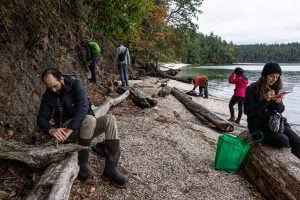
Wildlife
Our fascination with mammoths
How the legacy of these woolly giants persists in pop culture, storytelling, ecology and even the controversial idea of de-extinction
- 5019 words
- 21 minutes
This article is over 5 years old and may contain outdated information.
Environment

A new study out of the University of Alberta has found that isolation on an island helped one of the world’s last populations of woolly mammoths survive thousands of years longer than their continental counterparts — and also led to their demise.
The study, led by the university’s Duane Froese and published last week in the journal PNAS, suggests that the mammoths of St. Paul Island in the Bering Sea died of thirst.
St. Paul Island is one of four volcanic islands located about 400 kilometers west of Alaska. During the Pleistocene era, the island was part of the Bering land bridge, which connected North America and Eurasia and was actively travelled by woolly mammoths. At the end of the last ice age, rising sea levels forced the animals to higher ground in search of fresh water and ultimately stranded a small population of mammoths in isolation.
The island was initially well-equipped to support the animals — rich in vegetation, brimming with fresh water that collected in the former volcanic crater, and lacking natural predators. Human activity, which played a major role in the extinction of continental mammoths, was not recorded on St. Paul Island until the Russians arrived in the 1780s.
However, mammoths, like modern-day elephants, may have consumed anywhere from 50 to several hundred liters of water per day, and the large animals strained the island’s freshwater resources, not just through consumption, but erosion. As they drank from the island’s shallow caldera, they trampled the surrounding volcanic soil, pushing sediment into the water and rendering it unfit to drink.
“We see in the lake sediment record that very high rates of sedimentation occurred, which essentially shallowed the lake,” Froese explains. “The lake became very cloudy, turbid, and saline … [which is] the mechanism that we think ultimately led to their downfall.”
Other mammoth populations that contended with scarce resources show evidence of insular dwarfism, meaning subsequent generations of offspring became smaller so as to survive on less. However, fossil evidence showed the last St. Paul mammoths were of normal size, suggesting that once the drinking water dried up, there was no time for the animals to adapt.
Froese says there is a cautionary note in the tale of the St. Paul mammoths.
“It underscores the precariousness of island populations in changing climates,” he says, “and shows that very small changes can have very large impacts.”
Are you passionate about Canadian geography?
You can support Canadian Geographic in 3 ways:

Wildlife
How the legacy of these woolly giants persists in pop culture, storytelling, ecology and even the controversial idea of de-extinction

Environment
David Boyd, a Canadian environmental lawyer and UN Special Rapporteur on Human Rights and the Environment, reveals how recognizing the human right to a healthy environment can spur positive action for the planet

People & Culture
Naming leads to knowing, which leads to understanding. Residents of a small British Columbia island take to the forests and beaches to connect with their nonhuman neighbours

Environment
The planet is in the midst of drastic biodiversity loss that some experts think may be the next great species die-off. How did we get here and what can be done about it?